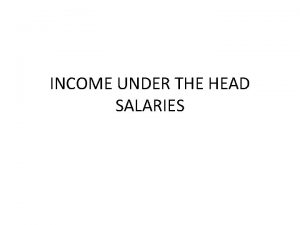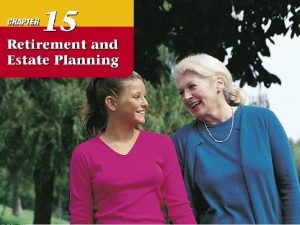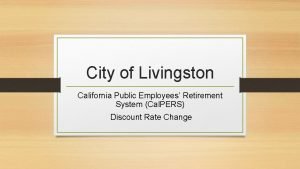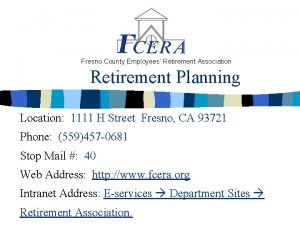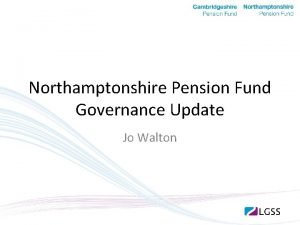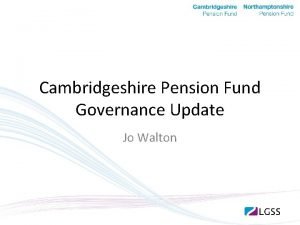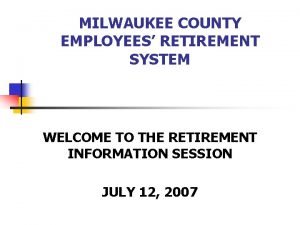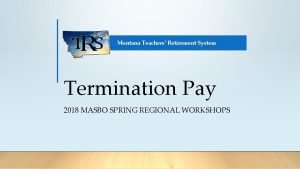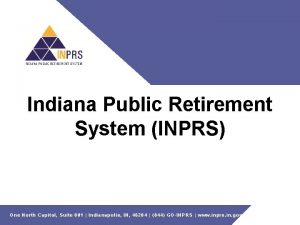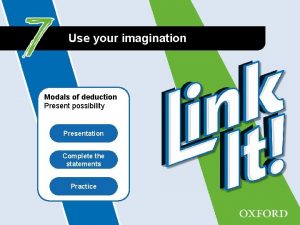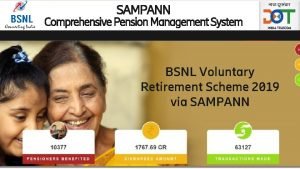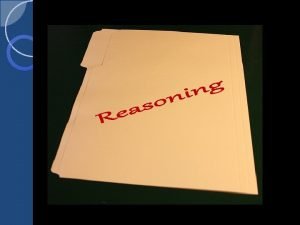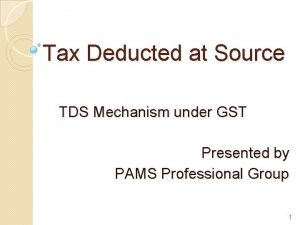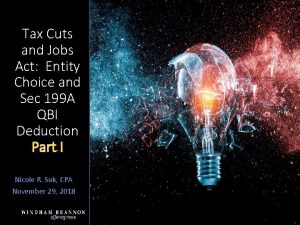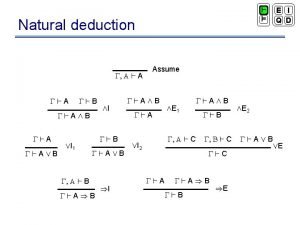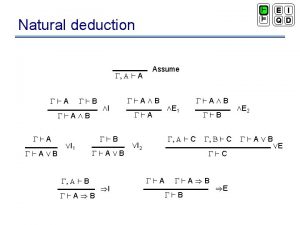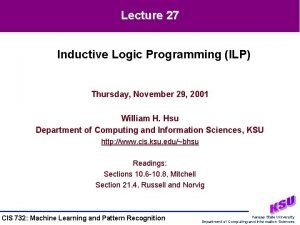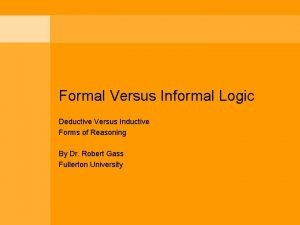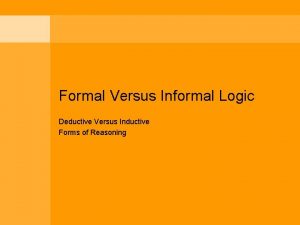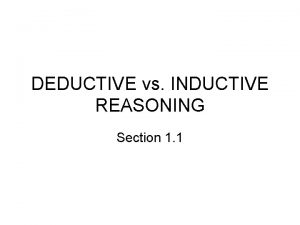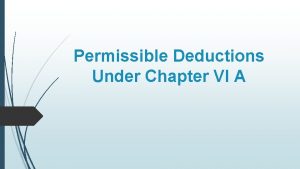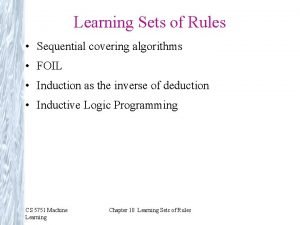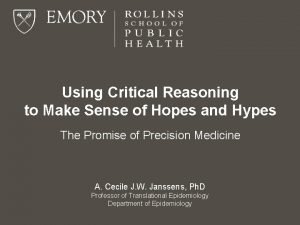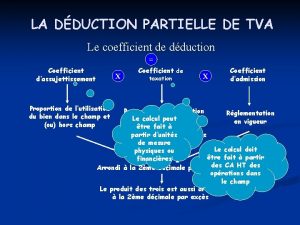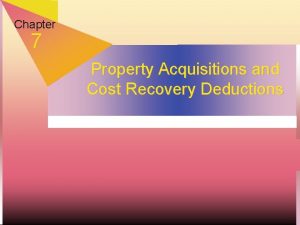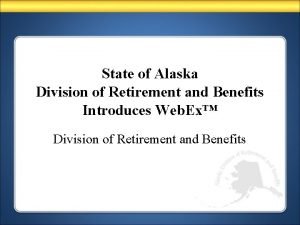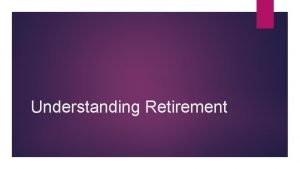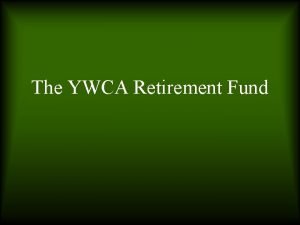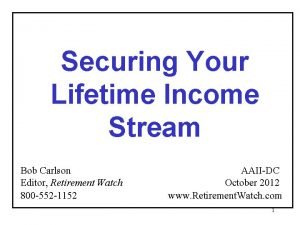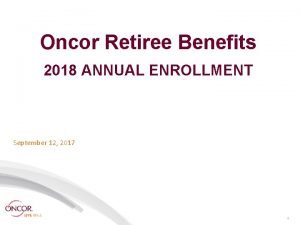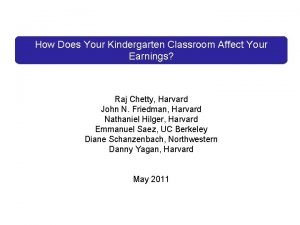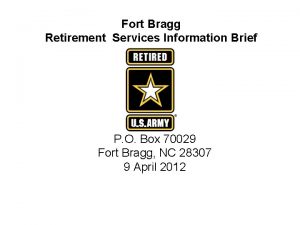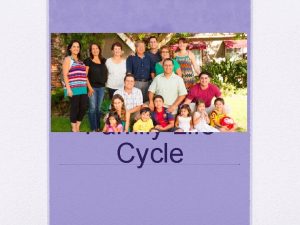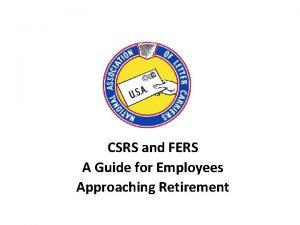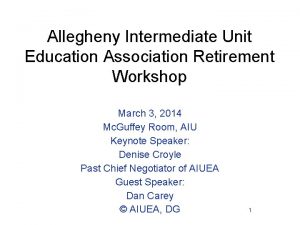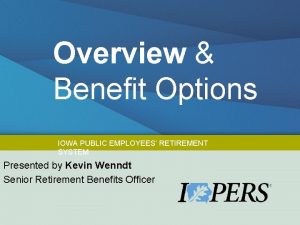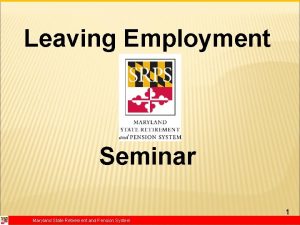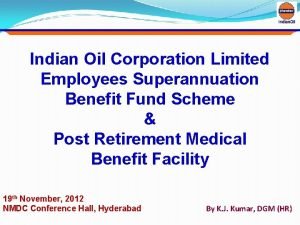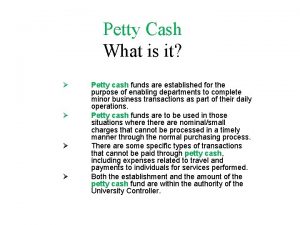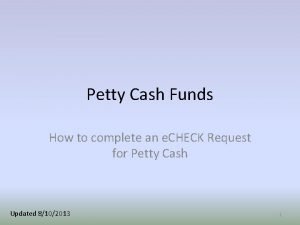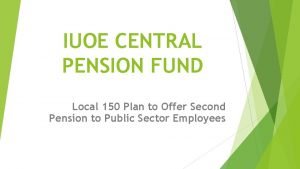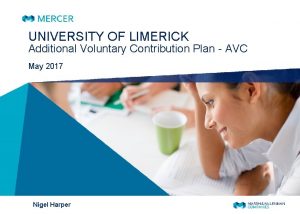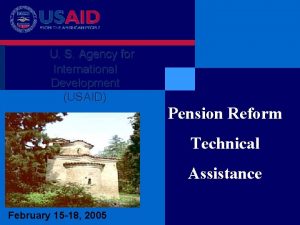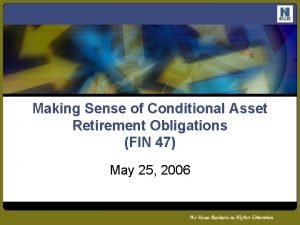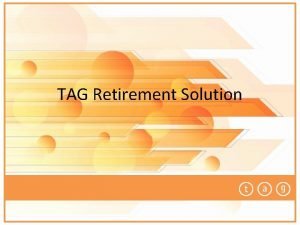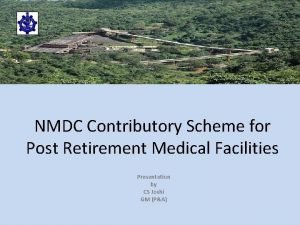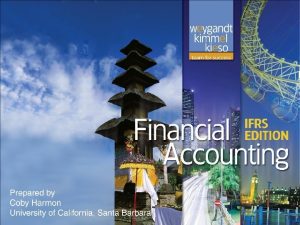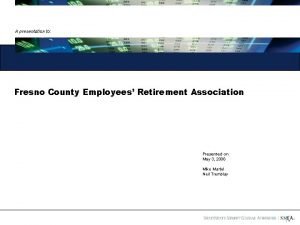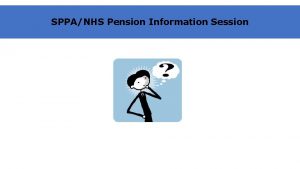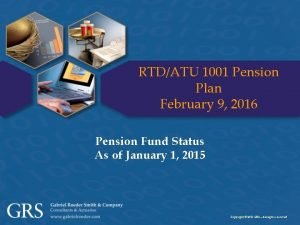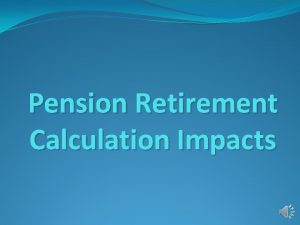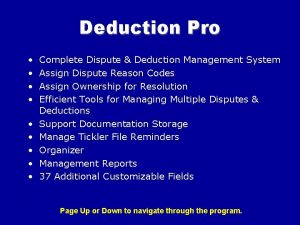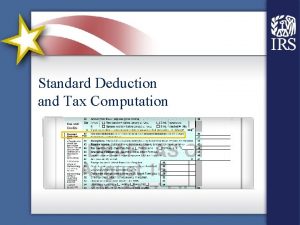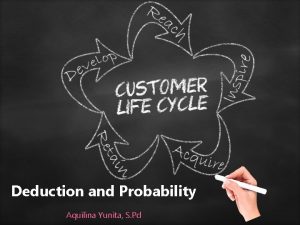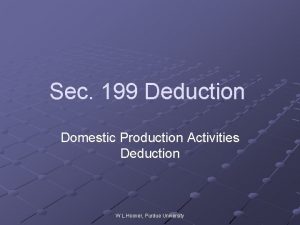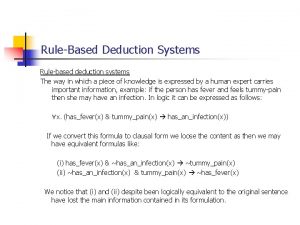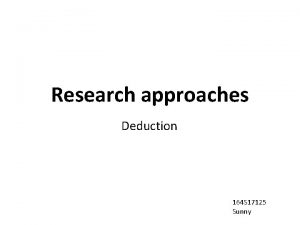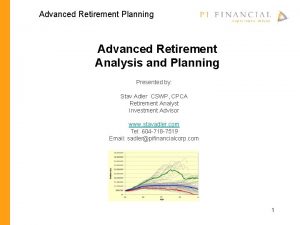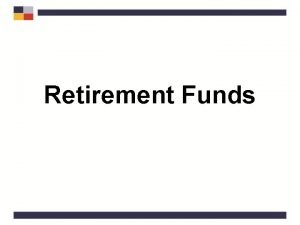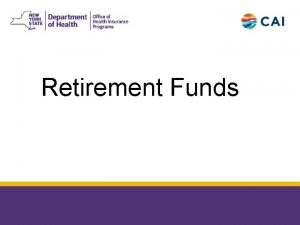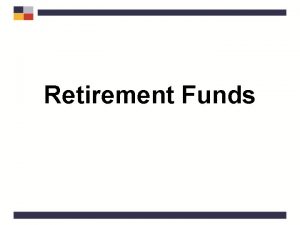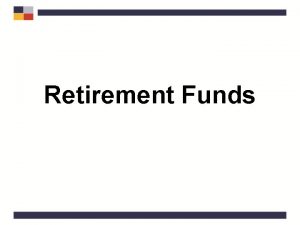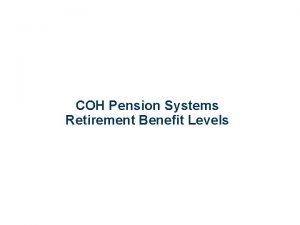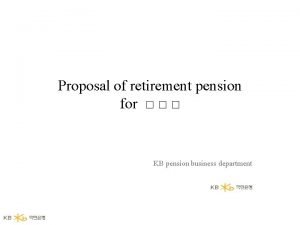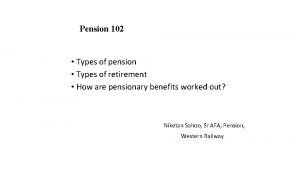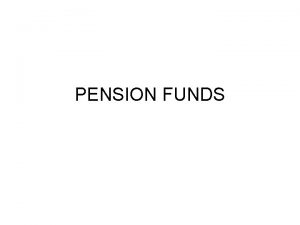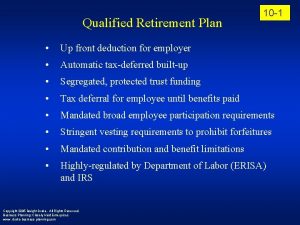Pension system and retirement planning Pension deduction is























































































- Slides: 87

Pension system and retirement planning

• • • Pension deduction is the biggest deduction from our incomes The core of financial planning is retirement planning Numbers and ratios change every year or every quarter. Figures presented here are for reference only.

Plan (1 of 2) • Describe the role of Old Age Security • Describe the role of the Canada Pension Plan • Explain the difference between defined-benefit and defined -contribution retirement plans • Describe types of individual retirement savings plans • The above plans form four layers of retirement incomes

Plan (2 of 2) • Describe types of retirement income conversion options • Present the key decisions you must make regarding retirement plans • Illustrate how to estimate the savings you will have in your retirement account at the time you retire

Brief introduction to retirement systems • • Old Age Security (OAS) and Canada Pension Plan (CPP) are government programs. The amount of CPP benefit is based on the amount of contribution. The amount of OAS benefit is based on the years of residence in Canada. It is also based on the other sources of retirement incomes. The more incomes you have, the less OAS you will receive. Company pension plans are employment based. Registered Retirement Saving Plan (RRSP) and other types of plans are tax deferred or tax deductable individual retirement accounts.

1. Old Age Security (OAS) Program (1 of 2) • Federal program, from general tax revenues • Criteria are age and residency requirements • lived in Canada at least 40 years since turning age 18, you will receive the full OAS pension • partial pension if lived in Canada fewer than 40 years but more than 10 years since age 18 • Age of eligibility is now 65, will gradually rise to 67 • Benefits may be deferred to up to age 70 with increase of 0. 6% per month that you defer your payment

Old Age Security (OAS) Program (2 of 2) • Maximum monthly OAS pension for the period April 2017 to June 2017 was $578. 53. The pension amount is adjusted quarterly. • OAS Clawback • OAS benefits are subject to a “means test” • If your income exceeds a certain amount, the benefits you will receive from the OAS program will be reduced • In 2017, the OAS pension was reduced by $0. 15 for every dollar of net income above $74 788, at $119 615, full repayment is required

Calculating the maximum pension benefit • From the formula for pension benefit, we can calculate the maximum monthly pension benefit. • For the year 2017, it is • (119615 -74788)*0. 15/12 = 560. 33 • This is roughly equal to but smaller than 578. 53, maximum pension benefit at the second quarter. • The maximum OAS pension payment is adjusted every quarter.

Guaranteed Income Supplement (GIS) • Payable to a pensioner who is at least 65 years of age and whose sole source of income is the OAS pension • 2017 max is $864. 09 monthly to a single, divorced, or widowed pensioner, or $520. 17 if married and both spouses getting OAS • If a pensioner receives any income other than the OAS pension, the GIS benefit is reduced by $0. 50 for every $1 of additional income

OAS GIS Example Martha is a 66 -year-old OAS pensioner married to Fred, who is a 65 -year-old OAS pensioner. Both of them were born and raised in Canada. They have no other sources of income besides their respective OAS pensions. Martha’s total income for the month would be $1098. 70 ($578. 53 + $520. 17). Similarly, Fred’s total income for the month would be $1098. 70. As a result, their combined annual income from OAS and GIS would be $26 368. 80 (calculated as [$1098. 70× 12]× 2).

Calculating one’s minimum income after retirement (Second quarter, 2017) • Suppose you don’t have any source of income. The amount of money you will get from the government is max OAS max GIS single max GIS couple 578. 53 864. 09 520. 17 total single monthly single annual income 1442. 62 17311. 44 per year total couple monthly couple annual income 2197. 4 26368. 8 per year

The minimum amount of retirement living in Canada • For a single, it is about 1500 dollar a month. • For a couple it is about 2000 dollar a month. • As minimum income residents, one will qualify for housing subsidies and other benefits.

Additional information about Old Age Security • Allowance Benefit (for spouse or common-law partner between age 60 and 64 whose spouse is receiving, or is eligible to receive, OAS and GIS) • Allowance for the Survivor Benefit, aged 60 -64 • Must apply for benefits • Inflation Protection • OAS is taxable benefit, GIS, allowance, and allowance for the survivor benefit are tax-free

Detailed information on OAS and GIS • Check the website • https: //www. canada. ca/en/services/benefits/publicpensions/cpp/old -age-security/payments. html

2. Canada Pension Plan (CPP) Program • A contributory pension plan program • Benefit based on dollar value of contributions and number of years you contribute • Apply to receive benefits as early as age 60 and as late as age 70, with normal retirement age 65 • Pensioners may benefit from a pension assignment: when a married or common-law couple shares their CPP retirement pensions to reduce income taxes

A brief history of CPP • CPP program started in 1966. The benefit rate is 25% of pensionable income (to be defined later) until 2018. • The contribution rate increased from 3. 6% in 1966 to 9. 9% in 2018. • The early CPP pensioners have high rate of return due to low contribution rate. • The later CPP pensioners have lower rate of return due to high contribution rate.

Brief history of CPP Maximum annual Basic total pensionable exemption contribution year earnings amount rate (%) 1966 5000 600 3. 6 1980 13100 1300 3. 6 1990 28900 2800 4. 4 2000 37600 3500 7. 8 2010 47200 3500 9. 9 2020 58700 3500 10. 5

CPP Program (1 of 3) • First $3500 of annual income is exempt from the CPP contribution calculation (your year’s basic exemption (YBE)) • At 2017, contribution rate is 9. 9% of your pensionable earnings (amount of income you earn between the year’s basic exemption (YBE) and the year’s maximum pensionable earnings (YMPE)) • 2017 YMPE was $55 300 • CPP contribution rate is split between employees and their employers (4. 95% each) • Self-employed individuals must contribute 9. 9%

CPP Example 1 Colleen works as an employee for Dynamex Industries. During 2017, she earned income of $60 000. Her spouse, Chris, is a self-employed carpenter. His earned income in 2017 was $38 000. Colleen’s CPP contribution amount would be calculated as follows: (The lesser of Annual Income or YMPE − YBE) × 4. 95% = ($55 300 − $3500) × 4. 95% = $2564. 10 Chris’s CPP contribution amount would be calculated as follows: (The lesser of Annual Income or YMPE − YBE) × 9. 9% = ($38 000 − $3500) × 9. 9% = $3415. 50

CPP Program (2 of 3) • Must apply to receive CPP benefits, 2017 max was $1114. 17 monthly • You may apply early or delay benefits • In 2017, between ages 60 and 65, benefits are reduced by 0. 60 % for every month early • In 2017, between ages 65 and 70, benefits are increase by 0. 7 % for every month late

CPP Program (3 of 3) • Inflation Protection (adjusted every January) • CPP retirement pension is a taxable benefit • Employee contributions can be claimed as a non-refundable tax credit • Employer contributions are a deductible business expense • Self-employed individuals can claim both the tax credit and the expense deduction

The calculation of CPP benefit (Brief) • The calculation is quite involved. For details, please check • https: //retirehappy. ca/how-to-calculate-your-cpp-retirementpension/ • Essentially, the amount of CPP payment is 25% of average monthly pensionable earning (AMPE). • CPP contribution starts at age 18, ends at 65 • Can remove 8 years with least income from calculation

Observation • A person with high income but short employment history pays very little CPP contribution. His CPP benefits will be high. • A person with low income but long employment history pays a lot CPP contribution. His CPP benefits will be low.

CPP Example 2 • Chris started working since he is 40. He earns 45, 000 dollar every year. He will retire at 65, after working for 25 years. Suppose the contribution rate is 10%. His annual CPP contribution is (45, 000 -3500)*10% = 4150 dollar. After Chris retires, his expected annual benefit is 45000*25% = 11250 dollar

CPP Example 3 • Jason started working since he is 18. He earns 30, 000 every year. He will retire at 65, after working for 47 years. His annual CPP contribution is (30, 000 -3500)*10% = 2650 dollar. Jason’s annual CPP benefit will be 30000*25% = 7500 dollar

CPP Example 4 (Continued from Example 2 and 3) • Suppose both Jason and Chris live to 80 years old. They will receive CPP benefit for 15 years. Calculate how much each contribute to and receive from CPP, without considering time value.

Solution • Jason’s contribution • 47*2650 = 124550 • Chris’ contribution • 25*4150 = 103750 • Jason’s benefit • 7500*15 = 112500 • Chris’ benefit • 11250*15 = 168750

Observation • Jason worked for long years. He contributed much, received little. • For him, even without considering for time value, his contribution is higher than his benefit. • Chris worked for shorter period. His amount of benefit is higher than the amount of contribution.

Start withdrawing CPP benefits at different ages • The following table comparing retirement at 60, 65 and 70. • The benchmark payment retiring at 65 is 13370 dollar annually, the maximum annual CPP benefit at 2017. • When start withdrawing at 60, CPP benefit is reduced by 0. 6%*12*5 = 36% • The annual CPP payment is • 13370*(1 -36%) = 8557 • When start withdrawing at 70, CPP benefit is increased by 0. 7%*12*5 = 42% • The annual CPP payment is • 13370*(1+42%) = 18985

CPP Alternatives (1 of 3) Accumulated CPP Retirement Pension Blank Mark Janet Bob Age Early Retirement Normal Retirement Late Retirement 60 $8 557 — — 61 17 285 — — 62 26 187 — — 63 35 268 — — 64 44 530 — — 65 53 978 13 370 — 66 63 614 27 007 — 67 73 443 40 918 — 68 83 469 55 106 — 69 93 695 69 578 —

CPP Alternatives (2 of 3) Blank Mark Janet Bob Age Early Retirement Normal Retirement Late Retirement 70 104 126 84 340 18 985 71 114 765 99 397 38 351 72 125 617 114 755 58 103 73 136 686 130 420 78 251 74 147 977 146 398 98 801 75 159 493 162 696 119 763 76 171 240 179 320 141 143 77 183 222 196 277 162 952 78 195 443 213 572 185 196 79 207 908 231 214 207 885

CPP Alternatives Blank Mark Janet Bob Age Early Retirement Normal Retirement Late Retirement 80 220 623 249 208 231 029 81 233 593 267 562 254 635 82 246 821 286 283 278 713 83 260 315 305 379 303 273 84 274 078 324 857 328 323 85 288 116 344 724 353 875 86 302 435 364 989 379 938

Early or Late: CPP Example (1 of 2) Mark has decided to apply for early CPP benefit, Janet will apply for CPP at the normal retirement age, and Bob will apply for CPP at age 70. The annual CPP benefit amount is calculated using the 2017 maximum monthly CPP retirement pension of $1114. 17. Inflation is assumed to be 2 percent per year. Exhibit illustrates that Janet will receive an annual CPP benefit of $13 370 when she turns age 65. This represents 100 percent of the amount she is eligible for, calculated as $1114. 17 × 12 = $13 370. Notice that Mark receives less than this amount ($8557) and that Bob receives more than this amount ($18 985).

• As mentioned earlier, in 2017, benefits are reduced by 0. 60 percent for every month that you take benefits early and are increased by 0. 70 percent for every month that you take benefits late, up to age 70. Mark is taking his CPP at age 60, which is 60 months earlier than the normal retirement age of 65. As a result, his CPP benefit is reduced by 36 percent, calculated as 0. 60 × 60 months. Bob is taking his CPP at age 70, which is 60 months later than the normal retirement age of 65. As a result, his CPP benefit is increased by 42 percent, calculated as 0. 7 × 60 months.

Early or Late: CPP Example (2 of 2) Exhibit shows that even though Janet and Bob start receiving CPP benefits later than Mark, the total CPP retirement pension received by Janet and Bob will eventually be greater than the amount received by Mark. In Janet’s case, her total CPP benefit will exceed that of Mark by age 75. Bob will exceed Mark’s total CPP benefit by age 80, and he will pass Janet by age 84. The amount of CPP you will collect over a period of time should not be the only consideration as to when you apply for CPP benefits. Exhibit implies that Mark, Janet, and Bob will each live until at least age 86. Although this may not be the case, Exhibit does illustrate that if you have other retirement income options, you should carefully consider the timing of your CPP retirement pension application.

Time value in consideration • The above discussion does not consider time value. • If time value is considered, one should take CPP as soon as one is retired.

The efficiency of government pensions • Many articles talked about the benefit we will receive upon retirement. Few articles talk about how much we have to pay for the potential benefit. We will briefly discuss the cost we pay for retirement.

• The easiest part to calculate is CPP (Canada Pension Plan) contribution. For people earning $55, 000 or higher a year, CPP contribution is over $5000, including the employer‘s contribution. • OAS (Old Age Security) benefits come from general tax income. It is not directly connected to your individual tax contribution. As OAS benefits cover everyone and benefit amount is often more than CPP, we can estimate our average tax contribution to OAS is at least $5000.

• With CPP and OAS, an average person pays about $10, 000 per year for retirement. •

estimate the efficiency of government retirement benefit. • Our average CPP and OAS contribution is $10, 000 a year. Over 40 years, our total contribution is $400, 000. • Average Canadian life span is 81 years old. On average, we will receive 81 -65 = 16 years benefits. The maximum retirement benefit for a single pensioner from the government is $24000, or $23997 to be precise, in the year 2017.

• But not every one is a single, and majority have other incomes, such as company pensions. The average payout may be much lower than $20, 000. Suppose the average payout is $20, 000. Over 16 years, the total payout is $320000, which is lower than the total contribution of $400, 000. • This has not considered time value.

Calculation of total retirement benefits from the government Maximum benefit for a single pensioner from the government (OAS + CPP) (578. 53+864. 09)*12 + 13370*0. 5 = 23997 Or monthly payment of 2000 dollars The first part is full OAS+ GIS. The second part is half of full CPP payment. The average CPP payment in 2018 is 664 dollars per month. Total monthly payment would be • (578. 53+864. 09) + 664*0. 5 = 1774 • • •

Basic pattern • CPP contribution rate website • https: //www. canada. ca/en/revenueagency/services/tax/businesses/topics/payroll-deductionscontributions/canada-pension-plan-cpp/cpp-contribution-ratesmaximums-exemptions. html • The contribution rate has been increasing over time.

CPP pension benefit • CPP benefit rate is 25% of pensionable earning after one is 65. • Will increase to 33% over time. • When? 2065

Concern about Retirement Benefits in the Future • In 2010, OAS and CPP represented more than 40% of seniors’ total income • A single pensioner receiving 100% OAS and CPP will receive $23 997/year, in 2017 • With high pension deduction at youth, young people have less resources to support large families. Fertility has dropped below replacement rate for several decades. • Population ages with low fertility rate. • Will government-sponsored benefits be available to future generations? • What other retirement income options are available to Canadian employees?

Retirement income: A comparison with prime time income • The median income of a Canadian household is less than 60, 000 dollar a year. If a family has two children, each person would have less than 15, 000 dollars a year. • If you are from such a family, the retirement income from government alone is higher than your income in your prime time. • There are other sources of retirement income, such as company pensions.

wealth distribution among generations • A good talk about wealth distribution among generations and its social impacts. • Have the boomers pinched their children’s future? • https: //www. youtube. com/watch? v=Zu. Xzvj. BYW 8 A&t=18 s

Some new development on CPP • A New Premium on Retirement, Globe and Mail, June 21, 2016 • https: //www. theglobeandmail. com/globe-investor/retirement/cppreform-whats-changing-and-how-it-will-affectyou/article 30551445/

Observations from the Globe and Mail article, (1 of 2) • How the increase of pension was introduced? • The federal finance department said the portion of earnings between $54, 900 and $82, 700 will have a different contribution rate for workers and employers, expected to be set at 4 per cent. • That is not the case. The contribution rate turns out to be the same in later years. • The statement was made in 2016. In 2017, the contribution rate for higher portion was the same. If the government could not keep the promise made less than one year ago, how likely it will keep the promises made decades ago?

Observations from the Globe and Mail article, (2 of 2) • The language of benefit and cost • Benefit is called benefit • Cost is not called cost in the article. It is called funding. The title of the section is How will higher benefits be funded.

3. Registered Pension Plans

Percentage of employees with a registered pension plan through their jobs Men Women Both 1977 52 36 46 2011 37 40 38

• Usually, jobs with pension plans are better jobs. • Over time, less and less men hold good jobs.

A brief history of employer sponsored retirement plans • In early years, most retirement plans are defined benefit plans. These plans are very generous to employees. In good economic times, companies can afford these plans. • Over time, many companies find defined benefit plans too expensive. They switch to defined contribution plans, which are cheaper for companies. • Right now, only well funded entities, such as governments and affiliated institutions, offer defined benefit plans.

Employer-Sponsored Retirement Plans • Defined-Benefit Pension Plans • Employer-sponsored retirement plan, guarantees a specific amount of income when you retire, based on salary and years of employment, risk on employer • May be contributory or non-contributory • Employer contributions based on actuarial values and assumptions • Actuary reassesses the plan every three years • Employer must make at least 50% of the contributions

Defined Benefit Pension Plans (1 of 2) • At retirement, an employee will receive a pension benefit based on a specific formula

Defined Benefit Plan Example Betty is retiring after 30 years of employment with a company. Her employersponsored defined-benefit pension plan uses a best average earnings calculation to determine her benefit amount. For each year of service, Betty earns an annual pension income of 1. 5 percent of her best average earnings. To calculate Betty’s pension income, her best three consecutive years of income are taken into account. Betty’s best earnings years occurred at the end of her career. The table below displays her income for the last five years of her career. Blank Annual Earnings 2013 2014 2015 2016 2017 $55 000 $70 000 $90 000 $100 000 $65 000 Betty’s best earnings years were 2014, 2015, and 2016. Her average earnings for this period were $86 667, calculated as ($70 000 + $90 000 + $100 000) ÷ 3. Her annual pension income will be $86 667 × 0. 015 × 30 = $39 000.

Defined Benefit Pension Plans (2 of 2) • Vested: a claim to money reserved for you upon retirement, even if you leave • Contributions must vest no later than two years after the employee becomes a plan member and must be used to provide retirement income • Vested benefits may be: • Left in your former employer’s pension account, • Transferred to your new employer, or • Transferred to an individual locked-in retirement account (LIRA) • Taxable benefit; employer contributions are a deductible business expense

Defined-Contribution Pension Plans • An employer-sponsored retirement plan where the contribution rate, not the benefit amount, is based on a specific formula • Plan may be contributory or non-contributory • Pension benefits are determined by the return on investment and the contributions accumulated each year, risk on employee

Receiving Retirement Income from Your Employer-Sponsored Retirement Plan • Normal retirement age: the age by which employees are entitled to receive 100% of the pension income they are eligible for • In many plans, the normal retirement age is 65 • Some plans use combo of age and years of service • In the event of the employee’s premature death, a reduced pension is often paid to a surviving spouse

4. Registered Retirement Savings Plans (RRSPs) • A private pension that enables us to save for our retirement on a taxdeferred basis • Contributions are tax deductible • Income earned on our investments is not taxed until we withdraw money at retirement • Anyone aged 71 years or younger with an earned income can contribute • Any withdrawal is subject to income tax

Spousal RRSPs • A type of RRSP where one spouse contributes and the other is the beneficiary • Advantages: • Allows the higher income spouse to receive a tax deduction for contributions • Provide a useful income-splitting tool

Tax-Free Savings Account (TFSAs) • Buy with after tax dollars • No income requirement • Any Canadian resident age 18 or older is eligible to open a TFSA account • Current annual contribution limit is $5500 • Increases once the cumulative annual effect of inflation justifies a $500 incremental increase • Unused contributions can be carried forward

TFSAs • Contribution are not tax deductible • Withdrawals are tax-free and can be re-contributed the following year • Can hold account until you die • Can be used for short-term as well as long-term goals • TFSA Account Types: • High-interest savings accounts, term deposits, GICs, mutual fund, selfdirected, and group TFSAs

• There are many optional retirement plans with tax benefits. It is up to individuals to determine how much one wants to pay. • Canadians only contribute about 5% of their eligible RRSP amount. • The majority of eligible quotas are unused. • People value today’s life more than future needs.

5. Locked-in Retirement Accounts (LIRAs) • A private pension plan created when an individual transfers vested money from an employer-sponsored pension plan • Main purpose is to provide an opportunity for employees who leave a company pension plan to take the value of their pension plan with them • Can’t make regular contributions • Funds can’t be withdrawn at will, must be used to provide retirement income

Retirement Income Conversion Options for RRSPs • By the end of the year in which you turn age 71, must cash in your RRSP or transfer into an income-producing plan • Fully taxable when cashed in, common to transfer all RRSP assets into a RRIF to defer tax • Do not have to sell assets when transferring • Percentage of assets held in RRIF must be taken into income each year (prescribed factors)

RRIF Prescribed Factors (1 of 2) CRA Prescribed Factors Expressed as Percentages of the RRIF Value Age of RRIF owner or spouse or common-law partner at January 1 RRIF Factor 63 0. 037037 74 0. 0567 85 0. 0851 64 0. 038462 75 0. 0582 86 0. 0899 65 0. 040000 76 0. 0598 87 0. 0955 66 0. 041667 77 0. 0617 88 0. 1021 67 0. 043478 78 0. 0636 89 0. 1099

RRIF Prescribed Factors (2 of 2) Continued Age of RRIF owner or spouse or common-law partner at January 1 RRIF Factor Age of RRIF owner or spouse or common-aw partner at January 1 RRIF Factor Age of RRIF owner or spouse or common-law partner at January 1 RRIF Factor 68 0. 045455 79 0. 0658 90 0. 1192 69 0. 047619 80 0. 0682 91 0. 1306 70 0. 050000 81 0. 0708 92 0. 1449 71 0. 0528 82 0. 0738 93 0. 1634 72 0. 0540 83 0. 0771 94 0. 1879 73 0. 0553 84 0. 0808 95 or older 0. 2000 Source: http: //www. taxtips. ca/rrsp/rrif-minimum-withdrawal-factors. htm. Reproduced with the permission of Tax. Tips. ca. (Accessed May 29, 2017).

RRIF Example Vicky turns 71 in 2017. Before the end of the year, she must either collapse her RRSP for its cash value or transfer her RRSP assets into an income-producing plan. Vicky decides to transfer her RRSP to an RRIF on November 15, 2017. As a result of this transfer, Vicky must make a withdrawal from her RRIF before December 31, 2018. The amount that must be withdrawn from an RRIF is prescribed by the CRA in an RRIF table. Exhibit shows an RRIF table highlighting the minimum amount that must be withdrawn. Assuming that Vicky is age 71 on January 1, 2017, she will have to withdraw 5. 28 percent of her RRIF assets during 2018. The amount that she has to withdraw will be based on the value of her RRIF assets on January 1. The RRIF table represents only minimum withdrawal amounts. Vicky has the option to cash in her RRIF at any time.

RRSP Conversion Options • Also consider an annuity: • Term annuity: a financial contract that provides a fixed sum of money at regular intervals until a specified year • Life annuity: a financial contract that provides a fixed sum of money at regular intervals for one’s lifetime • Registered annuities: annuities that are created using assets from an RRSP with no risk that your investment decreases in value

Annuity Example Vicky could have used her RRSP assets to purchase an annuity. For example, if she expects to need income that would be produced by her RRSP until age 91, she could use her RRSP to purchase a 20 -year registered term annuity. Of course, there is always the concern that Vicky may live past age 91. To avoid the risk that her annuity income will stop at age 91, she could use her RRSP to purchase a registered life annuity, which would guarantee her an income for life. On the other hand, what happens if Vicky dies the year after purchasing the life annuity? In this case, Vicky will lose most of her investment since the RRSP assets were used to purchase the annuity. To reduce this risk, Vicky could purchase a registered term certain annuity for 20 years. This type of annuity will guarantee an income payable to Vicky or her estate for 20 years.

Your Retirement Planning Decisions • Choose a retirement plan, determine how much to contribute, allocate your contributions • Which Retirement Plan Should You Pursue? • If your employer offers a plan, consider it first, your employer will make at least 50% of the contributions • If no employer-sponsored plan, consider investing in an individual retirement savings plan, such as an RRSP or a TFSA

Retirement planning example • Eric is planning for retirement 30 years from now. He plans to contribute 400 dollar a month. Suppose the return from his investment is 10%, 5% or 3% per annum, compounded monthly. What will be the total wealth at retirement for each level of return?

Solution • With monthly compounding, the number of total compounding for 30 years is • 12*30 = 360 • Compounding at 10%, total wealth at retirement is • 400*((1+10%/12)^360 -1)/(10%/12) = 904195 • Compounding at 5% • 400*((1+5%/12)^360 -1)/(5%/12) = 332903 • Compounding at 3%, • 400*((1+3%/12)^360 -1)/(3%/12) = 233094

Notes • With the same level of contribution, the final outcome can be very different, depending on the level of returns. • There is little control on the level of return we can expect.

Compounding and future value • Suppose you invest 5000 dollar. If the rate of return is 10%, 5%, or 3%, what will be the final wealth level after 40 years?

Solution • Compounding at 10% • 5000*(1+10%)^40 = 226296 • Compounding at 5% • 5000*(1+5%)^40 = 35200 • Compounding at 3%, • 5000*(1+3%)^40 = 16310

How Much Should You Contribute? • Determine your potential savings from contributing to your retirement plan • How much can you contribute per year? • What is the return you will earn on your investments? • How many years until your retirement?

How Much Retirement Income Will You Need to Live Comfortably? • Consider your existing assets and liabilities • Will you be supporting anyone? • What are your personal needs? • How many years will you live while retired?

How much one should save for retirement? • Given the difficulty of estimating how much income you will need at retirement, a safe approach is to recognize that OAS and the CPP will not provide sufficient funds and to invest as much as you on a consistent basis in your retirement plan. After maintaining enough funds for liquidity purposes, you should invest as much as possible in retirement accounts, especially when the contribution is matched by your employer. A common rule of thumb is to save at least 10 percent of your after tax earnings in a combination of retirement accounts.

Some personal reflections • Many years ago, some young faculty members were talking with a senior colleague approaching retirement. One person asked the senior colleague how much he saves for retirement. He said he doesn’t save a single cent. • This attitude is quite representative among Canadians with good pensions.

• Most large institutions provide company sponsored pension plans. Total contribution, including employer’s contribution, is about 10% of your income. An average Canadian worker makes about $50, 000 a year. His company pension contribution is about $5000 a year. Together with CPP and OAS contribution, we already pay about $15, 000 for retirement every year. •

• For most people, it is much more valuable to spend money when one is young than one is old. • We can have one more memorable vacation, one more precious child, and one more beautiful memory when we are old. • Why squeeze our youth to pursue a mirage of paradise in old age?

Median age of some countries • Japan 46 • Canada 42 • USA 38 • Mexico 28 •

• From the median age data, we can understand • Why Germany and Japan are declining • Why USA is more energetic than Japan • Why Mexicans are moving to USA • How about Canada? • Simple data contains a lot of information.

A final word on sustainability • If fertility rate is below 2, a society is unsustainable. • What is the proper level of retirement funding? • Retirement funding, as well as other fixed cost expenditures, should be reduced to levels so that the fertility rate will be higher than 2.
 Commuted pension vs uncommuted pension
Commuted pension vs uncommuted pension Chapter 15 retirement and estate planning
Chapter 15 retirement and estate planning Livingston federal employee retirement planning
Livingston federal employee retirement planning Retirement planning warsaw
Retirement planning warsaw Planning for retirement windsor
Planning for retirement windsor Fresno retirement planner
Fresno retirement planner Rule based deduction system
Rule based deduction system Pension planning northampton
Pension planning northampton Pension planning cambridgeshire
Pension planning cambridgeshire Pension planning cambridgeshire
Pension planning cambridgeshire Milwaukee county employees
Milwaukee county employees Montana teachers retirement
Montana teachers retirement Www.inprs.in.gov
Www.inprs.in.gov Unsound and sound argument
Unsound and sound argument Certainty examples
Certainty examples Modals of deduction and possibility
Modals of deduction and possibility What is inference and deduction
What is inference and deduction Comprehensive pension management system bsnl
Comprehensive pension management system bsnl Inductive logic definition
Inductive logic definition What is utr in gst
What is utr in gst Gst deduction at source
Gst deduction at source Qbi deduction example
Qbi deduction example Deduction practice pictures
Deduction practice pictures Induction philosophy
Induction philosophy Natural deduction cheat sheet
Natural deduction cheat sheet A/b/c rule
A/b/c rule Induction as inverted deduction
Induction as inverted deduction Induction vs deduction
Induction vs deduction Induction deduction
Induction deduction Induction v deduction
Induction v deduction Permissible deductions
Permissible deductions Offset multiplier
Offset multiplier Perfect modal verbs ejemplos
Perfect modal verbs ejemplos Foil algorithm
Foil algorithm Deduction
Deduction Kahulugan ng argumento
Kahulugan ng argumento Régularisation coefficient déduction tva
Régularisation coefficient déduction tva Inductive reasoning and deductive reasoning
Inductive reasoning and deductive reasoning Debugging by deduction
Debugging by deduction Cost recovery deduction
Cost recovery deduction State of alaska division of retirement and benefits
State of alaska division of retirement and benefits N planning
N planning Short, medium and long term planning in education
Short, medium and long term planning in education Corpus planning definition
Corpus planning definition Belinda doyle
Belinda doyle Ywca retirement fund
Ywca retirement fund Shakespeare lived almost entirely during the reign of
Shakespeare lived almost entirely during the reign of State of alaska retirement
State of alaska retirement Nancy invested 6000 in a bond
Nancy invested 6000 in a bond Bob carlson retirement watch
Bob carlson retirement watch Www.oncorretirees.com
Www.oncorretirees.com Momiji retirement home
Momiji retirement home Retirement savings percentile
Retirement savings percentile Fort bragg retirement services
Fort bragg retirement services Expanding stage of family life cycle
Expanding stage of family life cycle Tcg retirement
Tcg retirement 52-6083699
52-6083699 Psea retirement workshops
Psea retirement workshops 8776441774
8776441774 Wv peia retirement
Wv peia retirement Pers police
Pers police Ucf retirement
Ucf retirement Ipers retirement options
Ipers retirement options Md state retirement
Md state retirement Indian oil corporation retired employees
Indian oil corporation retired employees Prudential retirement app
Prudential retirement app Petty cash retirement
Petty cash retirement Cash
Cash Iuoe cpf
Iuoe cpf Retirement plan limerick
Retirement plan limerick Usaid retirement benefits
Usaid retirement benefits Fas 143 asset retirement obligation
Fas 143 asset retirement obligation Tag retirement
Tag retirement Retirement reimagined
Retirement reimagined Nmdc post retirement medical scheme
Nmdc post retirement medical scheme Learning in retirement carleton university
Learning in retirement carleton university Units of activity method
Units of activity method Fresno county employees retirement association
Fresno county employees retirement association Strategic planning vs tactical planning
Strategic planning vs tactical planning Planning balance sheet in urban planning
Planning balance sheet in urban planning Role segmentation workforce planning
Role segmentation workforce planning Perencanaan kapasitas dan agregat
Perencanaan kapasitas dan agregat Aggregate capacity planning
Aggregate capacity planning Aggregate planning is capacity planning for
Aggregate planning is capacity planning for Is earth a closed system or open system
Is earth a closed system or open system Site:slidetodoc.com
Site:slidetodoc.com Sppa pension
Sppa pension Rtd/atu 1001 pension plan
Rtd/atu 1001 pension plan
